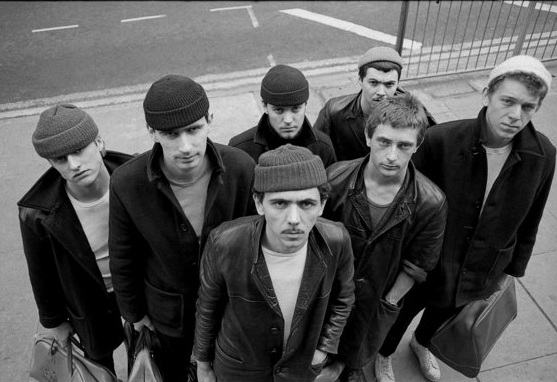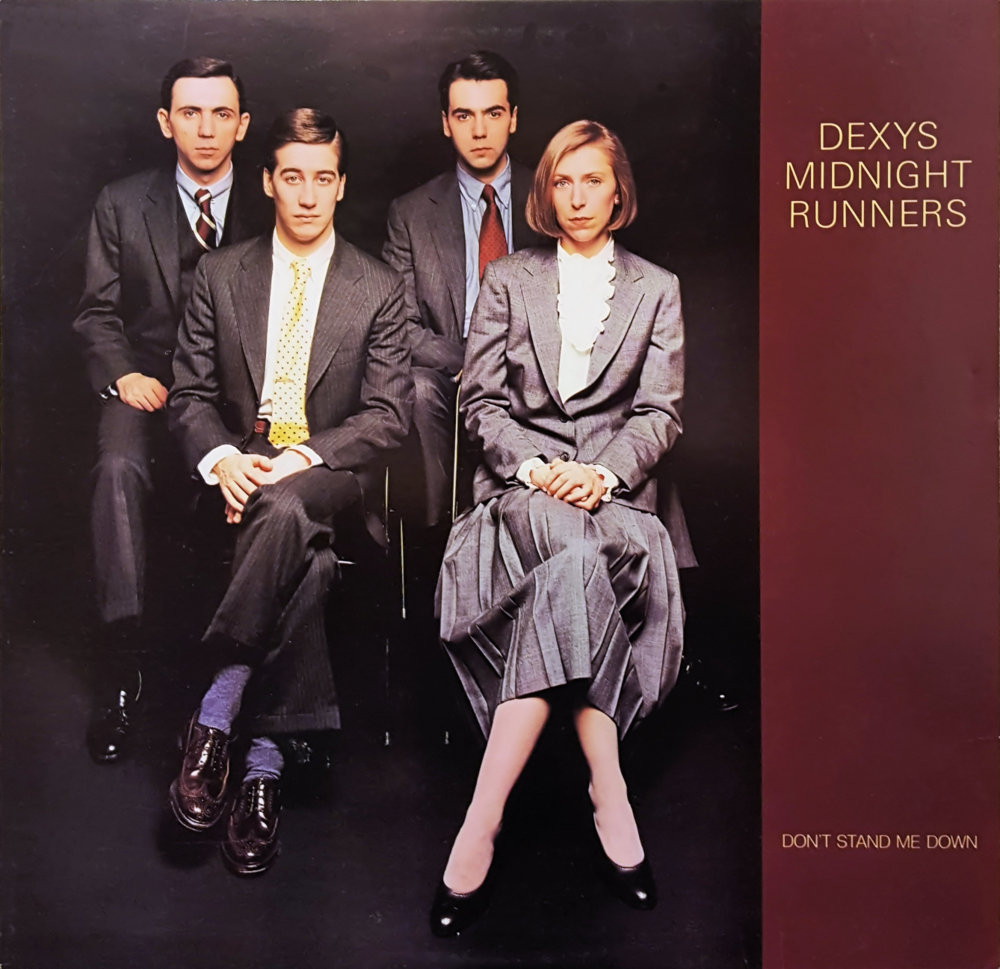Burn It Down: A Retrospective of Dexys Midnight Runners
Click below on the streaming service of your choice to listen to the playlist as you read along.
In North America, Dexys Midnight Runners was best known for their ubiquitous ‘80s hit, “Come on Eileen.” That single, and in many respects the band itself, was derided as much as loved, and thus international appreciation for the band was stymied to a degree more than was fair given the quality of their music. Their first two albums were simply fun, energetic, wonderful romps of old-school soul and blues, and they were – and are – two of my favourite albums.
Dexys Midnight Runners in 1980
Everything about DMR revolved around Kevin Rowland. The singer and songwriter was born in 1953 in Wolverhampton in central England near Birmingham. His parents were Irish and he lived in Ireland for a few years during his infancy. The early influences on his music were glam acts like Roxy Music, but after a brief foray into punk with the band, Killjoys, who released a single in 1977, “Johnny Won’t Get to Heaven,” he turned thereafter into music inspired by the northern soul movement and the sounds of his Irish heritage. These were the driving features of the music of Dexys Midnight Runners, formed in 1978 with fellow Killjoy, Kevin Archer, and named after the energizing drug of choice for the dance-fuelled northern soul scene, dextroamphetamine.
Over the course of ten years DMR released three albums, thirteen singles, and had solid success in the UK with two LPs and four singles cracking the top ten, including two #1 singles. Internationally, their reputation was made with the second album, 1982’s Too-Rye-Ay, and the single, “Come On Eileen.” The album reached #14 in the US and the single went to #1 in countries around the world, including the US and UK. Their tenure was marked with chronic line-up changes as band members fled the demanding and temperamental personality of Kevin Rowland. One example was, during the build-up to Too-Ry-Ay with the band’s second line-up (it almost completely changed from the first album to the second), he enforced a strict group running and exercise routine and banned drinking before shows. He also regularly fought with the music press, who like the fellow band members, found him to be more hassle than he was worth.
DMR in their boxer’s boots
The band also went through several fashions, dressing in the working class styles with donkey or leather jackets and wool hats for the first LP, then as boxers in sweatshirts, boxers boots, and ponytails before moving to a farmer/hillbilly/gypsy look that combined overalls, scarves, and leather waistcoats. It was a distinctive look amidst the blow-dried hair and heavy make-up of glam metal and new wave. It was also the look that became most identified the band as it coincided with the Too-Ry-Ay period and the “Come On Eileen” video. For their final album they went to suits, taking a posh, corporate look, which not only was a complete reversal of their prior looks, but like all their other fashions, seemed to have nothing to do with their music.
Along with the constantly changing line-up and fashions was, not surprisingly, a regular reinvention of their sound, though with the unifying thread of soul music. The only reason we’re talking about this band today was possibly the same reasons they were a difficult band to warm up to in person, the bold personality of Kevin Rowland. His knack for great hooks, moments of infectious energy or sublime subtlety, and then the fantastic bridges between, rarely left their music waning or wanting and drew you in, song after song. The only misstep was on the final album, Don’t Stand Me Down, when the songs lengthened unnecessarily and Rowland’s penchant for conversational vocals were elevated to a distracting degree. Their vocals often had a call-and-response element or layered exchanges between Rowland and the band, which helped with the energy and infectiousness, but on the last album these were lost to the straight-up, pointless discussions. Rowland did, however, have a very distinct vocal style full of character. It was so much a part of the band’s sound that if you find yourself loving or hating DMR, it’s likely as much due to your reaction to his voice. I’ve always been a sucker for a unique voice, and loved it when Kevin moved from low, sultry growls into falsetto exclaims or drew you in with an effective, passionate line perfectly blended with a tonal or tempo change. His voice was every bit an essential element to their sound.
Being soul-inspired, the band’s first album, Searching for the Young Soul Rebels, was energized with fantastic horn blasts that gave DMR an interesting position in the musical landscape, like a cross between ska, punk, blues, gospel, and soul. “Seven Days Too Long” has long been one of my favourite songs that captured the spirit of these genres in wonderful mix; it was a cover of a northern soul song, originally by Chuck Wood in 1967. “Tell Me When My Light Turns Green” and “Thankfully Not Living in Yorkshire It Doesn’t Apply” had great turns and moved through tempo changes in ways that drove straight into your musical soul. These were tunes in which Rowland’s falsetto turns either offered a pleasing change to the band’s sound or sent the listener running with hands over ears. The band was also solid on the downtempo songs, as evident in tracks like “I Couldn’t Help If I Tried,” which rode a lovely tension between the long notes from the horns and Rowland’s desperation edged vocals. Throughout though, such songs like “Burn it Down” and “There There My Dear” blended melody and rhythm and kept the album from hitting any lulls, frequently picking you up and setting you down in its passionate embraces.
DMR, into the overalls and scarves
Too-Rye-Ay had a pronounced turn from the soul-infused horns, though they were still there but not as pronounced, to the use of violin and strings, allowing Rowland to bring more of his Irish heritage into the music. The strength of the songs continued though, with nary a weak song on the album. “Come On Eileen” was a blessing and a curse for the band. It was easily their most pop-oriented tune, and thus not surprisingly the one that brought them unequalled success in their career, but given their distinct sound left DMR as a novelty act in the early ‘80s and, certainly in North America, rendered as a one-hit wonder. Thus, the depth and richness of the entire album was overlooked by wider audiences.
I bought Too-Rye-Ay as a Christmas present for my brother in 1982 (recommended to me by his former high school mate Stephen Scott, who was working at Music World at Yonge & Gould Streets that year; I bought it along with ABC’s Lexicon of Love) and promptly taped it onto a cassette, to which I played assiduously all through 1983. It was a fantastic listen for my trips to and from school on my Walkman. To this day, it’s hard not to listen to “Until I Believe in My Soul” or “Plan B,” with its sudden jump into overdrive a third of the way into it, at anything less than full volume. The second side combo of “Plan B/I’ll Show You/Liars A to E” was a great run of songs, to say nothing of the closing tandem of “Until I Believe in My Soul” and “Come On Eileen.” It was just a phenomenal side of an album. The first side rode more heavily on the Celtic flavour and had the sublime “Let’s Make this Precious” and the excellent Van Morrison cover, “Jackie Wilson Said (I’m in Heaven When You Smile).”
On to the suits and buttoned-down look
My brother bought Don’t Stand Me Down when it came out in 1985 and I again taped it, but listened to it a lot less prodigiously. The twelve-minute conversation/song, “This is What She’s Like,” provided both the album’s strongest musical moment and it’s most infuriating, as you had to listen to a tedious dialogue between Kevin and Billy Adams before the song got going, though it did provide a nice build-up along the way via Kevin’s transition from speaking to singing. If the three-minute version were available, I would have included it in the playlist. The album was pretty decent and was again structured around the violin playing of Helen O’Hara (a Brit with last name, Bevington, she adopted the Irish stage name to fit with the music), but its less accessible sound, Rowlands initial refusal to release any singles, and continued divergence of their sound with the trends of the ‘80s (though they would have fit well with the rise of The Waterboys at that time) left DMR struggling. They broke up in 1987.
Rowland went on to a poorly received solo career and struggled with a reinforcing downward spiral of problems relating to money, depression, and addiction through the 1990s. In 2003 he returned with a band that featured a few ex-DMR members including Paterson and Mick Talbot and released a greatest hits package that included new songs. Eventually there would be two new albums, both released under the shortened name, Dexys. In 2012 there was One Day I’m Going to Soar and in 2016, Let the Record Show: Dexys Do Irish and Country Soul, which was exactly what the title indicated, a collection of Irish cover songs. The albums didn’t have the jump and distinctive rock feel of the original DMR, but still offered occasional moments when Rowland’s voice and the music came together in engaging turns.
In more recent times
Any band with a distinctive sound and forceful personality are going to be loved and loathed in equal turns, and for DMR that was the case. “Come On Eileen” made them a novelty act in North America and mostly overlooked, but in their native UK they were the real deal, providing a solid trio of albums and some of the most satisfying tunes of their era. As one of my favourite bands of my early teen years I have a special fondness for their sound, especially those first two LPs, and they still occupy a prominent place in my regular listening. If you recall them only for their hit song, hopefully you’ll push past the distractions of Kevin Rowland and their look to discover the joys of their deeper album cuts and lesser known singles, or discover them anew and add their rich sound to your own listening habits.
The Playlist - song \album (year)
Burn It Down \ Searching for the Young Soul Rebels (1980)
Tell Me When My Light Turns Green \ Searching for the Young Soul Rebels (1980)
Seven Days Too Long \ Searching for the Young Soul Rebels (1980)
I Couldn’t Help If I Tried \ Searching for the Young Soul Rebels (1980)
Thankfully Not Living in Yorkshire It Doesn’t Apply \ Searching for the Young Soul Rebels (1980)
There There My Dear \ Searching for the Young Soul Rebels (1980)
Let’s Make This Precious \ Too-Rye-Ay (1982)
Plan B \ Too-Rye-Ay (1982)
I’ll Show You \ Too-Rye-Ay (1982)
Liars A to E \ Too-Rye-Ay (1982)
Until I Believe In My Soul \ Too-Rye-Ay (1982)
Come On Eileen \ Too-Rye-Ay (1982)
Let’s Get It Straight from the Start \ non-album single (1982)
The Occasional Flicker \ Don’t Stand Me Down (1985)
One of Those Things \ Don’t Stand Me Down (1985)
Listen to This \ Don’t Stand Me Down (1985)
She Got a Wiggle \ One Day I’m Going to Soar (2012) - as ‘Dexys’














